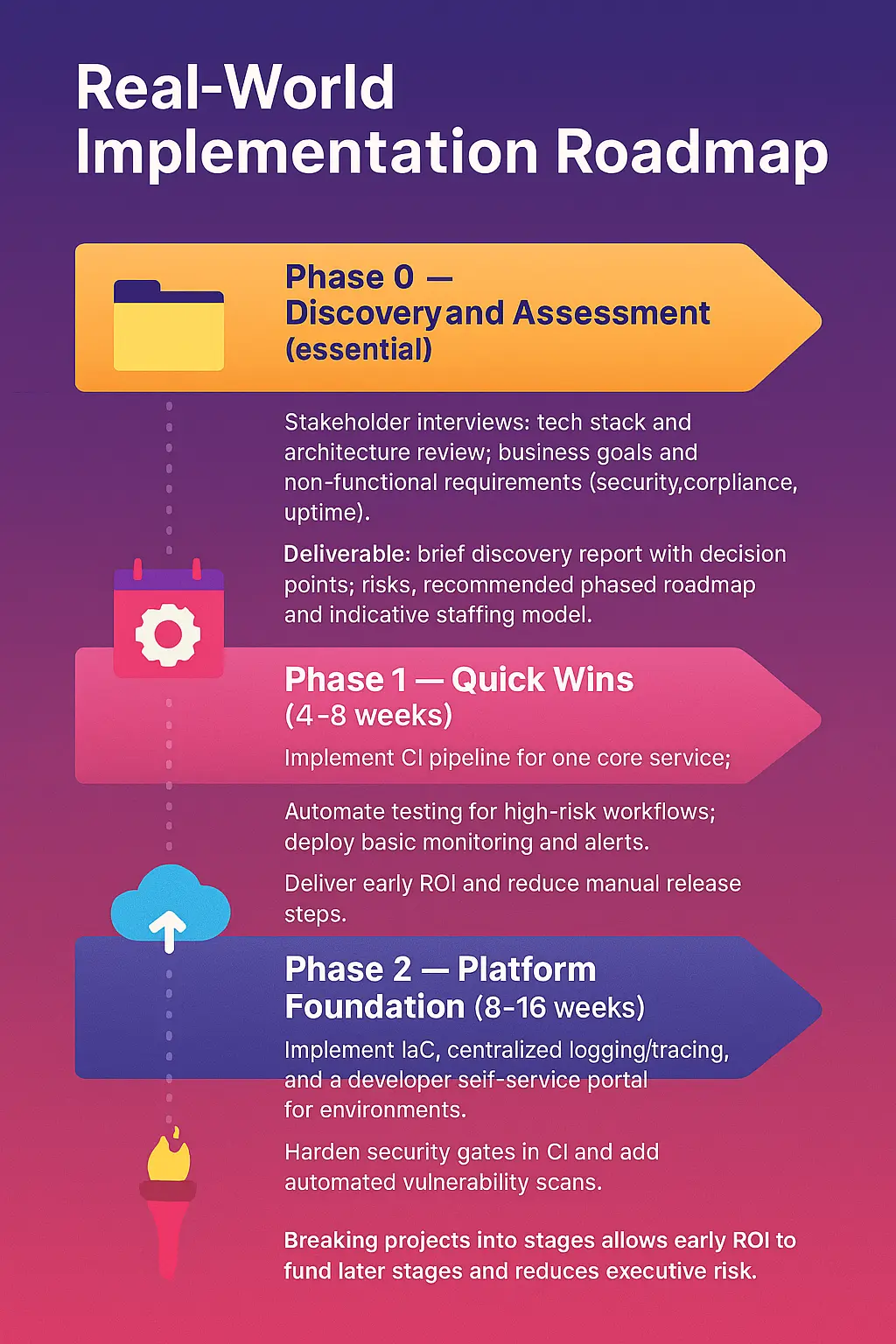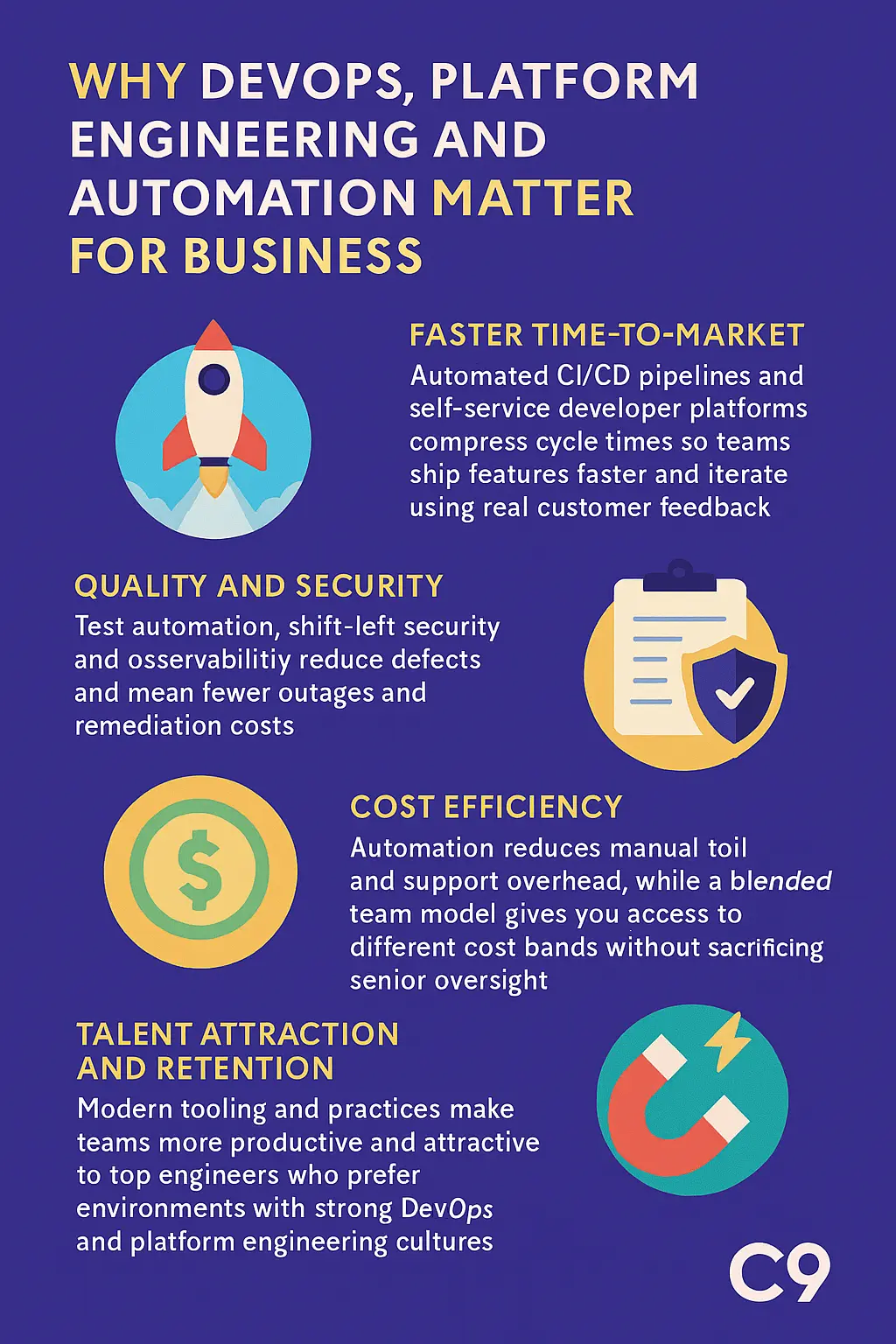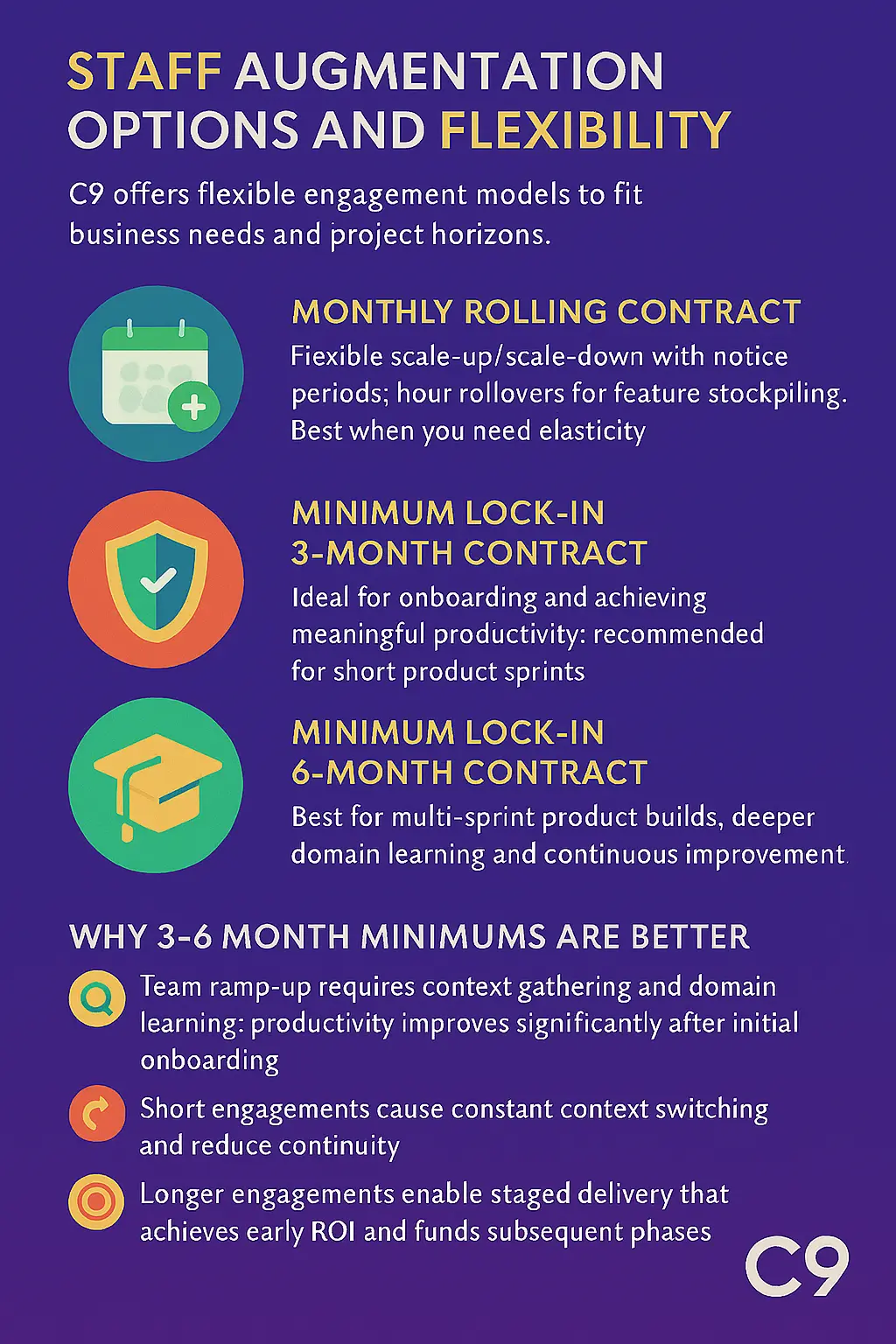Pain: Many Sydney and Brisbane businesses struggle with slow releases, ballooning maintenance costs and the inability to attract senior engineering talent. These problems block growth, frustrate executives and leak margins.
Agitate: Rushed projects lead to outages, hidden technical debt and vendor lock‑in. Low‑cost quick fixes often cost far more in remediation, audits and lost customers. Executives need predictable outcomes, not surprises.
Solution: DevOps, platform engineering and automation—deployed by an experienced partner—deliver faster time‑to‑market, higher quality and an environment that attracts and retains skilled engineers. C9 blends local accountability with offshore capacity, embeds knowledge transfer and starts every engagement with a focused discovery process so budgets and timelines remain realistic.
This article is aimed at Sydney and Brisbane business owners and executives considering software development partners. It focuses on outcomes: speed, quality, security and predictable delivery.
Why DevOps, Platform Engineering and Automation Matter for Business

-
Faster time‑to‑market: Automated CI/CD pipelines and self‑service developer platforms compress cycle times so teams ship features faster and iterate using real customer feedback.
-
Quality and security: Test automation, shift‑left security and observability reduce defects and mean fewer outages and remediation costs.
-
Cost efficiency: Automation reduces manual toil and support overhead, while a blended team model gives you access to different cost bands without sacrificing senior oversight.
-
Talent attraction and retention: Modern tooling and practices make teams more productive and attractive to top engineers who prefer environments with strong DevOps and platform engineering cultures.
Business outcomes are measurable: shorter release windows, lower mean time to recovery (MTTR), fewer critical incidents and reduced cost per feature.
The Pain Executive Teams Feel Right Now
-
Manual builds, manual deployments and manual QA create bottlenecks that block product launches.
-
Single‑person knowledge silos create high vendor and staff risk if someone leaves.
-
Freelancers or cheap app‑builders deliver prototypes without security, tests or documentation.
-
Unclear scope or skipping discovery leads to optimistic deadlines and expensive change orders.
These are common problems that erode confidence in technology investments and slow commercial momentum.
How Platform Engineering and DevOps Solve These Problems
-
Developer self‑service platforms standardise environments and remove repetitive setup time, reducing onboarding from weeks to days.
-
CI/CD pipelines automate build, test and deployment steps so releases become routine, auditable and reversible.
-
Infrastructure as Code (IaC) ensures environments are reproducible and versioned, reducing drift and unexpected differences between staging and production.
-
Observability and SRE practices give engineering teams early warning about production issues and enable proactive remediation.
The result: faster, safer releases and a platform your business can scale across teams and geographies.
Real‑World Implementation Roadmap

Phase 0 — Discovery and Assessment (essential)
-
Stakeholder interviews; tech stack and architecture review; business goals and non‑functional requirements (security, compliance, uptime).
-
Deliverable: brief discovery report with decision points, risks, recommended phased roadmap and indicative staffing model.
Phase 1 — Quick Wins (4–8 weeks)
Phase 2 — Platform Foundation (8–16 weeks)
-
Implement IaC, centralised logging/tracing, and a developer self‑service portal for environments.
-
Harden security gates in CI and add automated vulnerability scans.
Phase 3 — Scale and Handover (ongoing)
-
Onboard more teams to the platform, refine SLOs/SLIs, embed knowledge transfer, and iterate on automation to unlock further efficiencies.
Breaking projects into stages allows early ROI to fund later stages and reduces executive risk.
Discovery Calls — Why They Matter and Why Skipping Them Is a Bad Idea

Discovery calls are not a sales ritual — they are the first risk‑management step in a successful software project. Skipping discovery commonly causes scope creep, unrealistic budgets and missed regulatory or integration complexities.
What a C9 Discovery Call Looks Like
-
Pre‑call questionnaire to gather context and documents.
-
Stakeholder alignment to identify decision makers and KPIs.
-
Current‑state mapping: architecture, integrations, data sources and constraints.
-
Risk and dependency review: third‑party APIs, licences, compliance requirements.
-
Phasing and timeline mapping: MVP definition and staged delivery plan.
-
Indicative sizing and next steps: whether a deeper discovery workshop is required.
-
Deliverable: short discovery report with milestones, assumptions and recommended Statement of Work.
Why Discovery Is Not a Waste of Time
-
It turns unknowns into defined tasks with clear owners and timelines.
-
It enables realistic cost estimates and staged funding.
-
It exposes hidden compliance or data quality issues early.
-
It helps allocate the right mix of inshore/offshore resources to match commercial and technical needs.
Executives who prioritise a structured discovery reduce downstream rework and protect executive time.
The “AI Cowboy” Problem and Vibes Coding: What Business Owners Need to Know

“AI Cowboys” describes low‑cost AI app builders or freelancers who rely on quick code generation, templates or “vibes coding” (fast, informal wiring of components without disciplined architecture). These approaches can look attractive short‑term but carry long‑term costs.
Risks of AI Cowboys and Vibes Coding
-
Hidden technical debt: generated code often lacks tests, documentation and clear architecture.
-
Security and compliance gaps: automated generators rarely implement hardened security controls.
-
Knowledge loss: when the builder vanishes, the product becomes costly to operate or extend.
-
Performance and maintainability issues: shortcuts cause scalability problems under load.
C9’s Approach to Mitigating These Risks
-
Rigorous architecture reviews, automated test coverage and security checks baked into CI.
-
Structured knowledge transfer: documentation, training and pairing sessions so your internal teams understand the system.
-
Delivery of integrated teams, not one‑off developers, to maintain continuity and institutional knowledge.
C9’s advantage is delivering production‑worthy systems with accountability and long‑term maintainability.
Why C9 Compared with Hundreds of Other Developers
-
Blended hybrid team model: senior inshore architects and product leads in Sydney and Brisbane, supported by cost‑efficient offshore engineering capacity. This balance secures local accountability while optimising cost.
-
Knowledge transfer is embedded: documentation, training and pairing are part of every engagement so your team can operate independently.
-
Integrated teams, not single hires: we provide product teams (DevOps and platform engineers, QA, product manager, UX) for end‑to‑end delivery.
-
Local business alignment: Australian commercial practices, time overlap and local governance enable smoother executive engagement.
-
Proven focus: custom software, apps, integration and database development for Australian enterprises and SMEs — https://www.c9.com.au/
C9’s model reduces vendor risk and avoids the “single developer” failure mode common with freelancers and unstructured outsourcing.
Staff Augmentation Options and Flexibility

C9 offers flexible engagement models to fit business needs and project horizons.
-
Monthly rolling contract: flexible scale‑up/scale‑down with notice periods; hour rollovers for feature stockpiling. Best when you need elasticity.
-
Minimum lock‑in 3‑month contract: ideal for onboarding and achieving meaningful productivity; recommended for short product sprints.
-
Minimum lock‑in 6‑month contract: best for multi‑sprint product builds, deeper domain learning and continuous improvement.
Why 3–6 Month Minimums Are Better
-
Team ramp‑up requires context gathering and domain learning; productivity improves significantly after initial onboarding.
-
Short engagements cause constant context switching and reduce continuity.
-
Longer engagements enable staged delivery that achieves early ROI and funds subsequent phases.
Staff Augmentation FAQs
-
Q: What roles can you supply? A: Developers, DevOps/platform engineers, QA, product managers, UX designers and solution architects as integrated teams.
-
Q: Will someone work 9–5 in our Sydney office? A: Our model uses remote hired talent rather than in‑house local hiring. Clients should not expect an onsite 9–5 resource; we provide scheduled overlap windows and regular checkpoints.
-
Q: Can we scale down quickly? A: Monthly contracts allow scaling with notice; lock‑in contracts provide stability for critical stages.
-
Q: Do you only provide single developers? A: No — we provide multi‑role integrated teams to ensure product continuity and quality.
Rates, Transparency and Commercial Models
C9’s FY25/26 rates vary by skillset and assume a mix of onshore and offshore C9‑directly hired talent, offering savings compared to inflated single‑hour rates for individual roles. Rates are subject to CPI adjustments. Use of local resources only will change pricing. Additional discounts apply for long‑term and multi‑resource (>3) contracts. Monthly packages can be scaled with notice and include hour rollovers for feature development.
We prioritise transparent commercial models: staged milestones, clear assumptions, and training/knowledge transfer included in the scope.
Why Indicative Pricing Often Fails — Example and Comparison

Indicative pricing (a quick, high‑level estimate) is attractive but frequently inaccurate because it misses integration complexity, data quality work and compliance demands.
Made‑up Example: CRM Integration and CI/CD Setup
-
Indicative quote: 120 hours × $150/hr = $18,000. This is based on a surface assumption of a clean CRM and straightforward API.
-
Discovery outcome: two‑week workshop reveals messy legacy data, API rate limits and security hardening needs adding 80 hours (data clean up 40h, security 24h, stakeholder training 16h). Total scoped effort: 200 hours. If rounded to nearest week for contracting, the practical cost: 200 × $150 = $30,000.
Impact: The indicative quote underestimates by $12,000 and creates scope friction. A discovery‑based approach gives a staged contract with early MVP in 6 weeks and reduces surprises.
Why Discovery‑Based Pricing Is Preferable
-
It identifies unknowns early, allowing you to phase work and realise early ROI.
-
It supports phasing payments and delivering a usable MVP quickly, which can fund later stages.
-
It prevents adversarial change orders and keeps stakeholder trust intact.
Case Study Snapshot (Executive‑Level Outcomes)
-
SaaS company in Sydney: Reduced deployment time from 2 days to under 1 hour; incident recovery costs down 60% after automated rollbacks and observability.
-
Logistics platform in Brisbane: 30% faster partner onboarding after developer self‑service environments were introduced.
-
Financial services: Automated compliance checks in CI pipelines reduced audit preparation from weeks to days.
These examples are indicative of the outcomes typical of a disciplined DevOps and platform engineering programme.
Conclusion
Pain recap: Manual processes, hidden technical debt and inexperienced app builders lead to delayed releases, higher costs and security risk for Sydney and Brisbane businesses.
Solution recap: DevOps, platform engineering and automation—delivered by a partner who starts with discovery and ensures knowledge transfer—reduce risk, accelerate delivery and make your engineering organisation more attractive to talent.
Final nudge: Avoid speculative low‑cost “AI Cowboys” and one‑off freelancers. Invest in a discovery‑first, staged approach with a blended inshore–offshore partner like C9 to deliver sustainable, measurable results.
Book a discovery call with C9 to surface decision points, map timelines and receive a short discovery report with phased recommendations and an indicative phased budget. A single focused discovery call protects your budget and ensures the first delivery phase drives real ROI. Start with a short pre‑call questionnaire to make the meeting productive: https://www.c9.com.au/